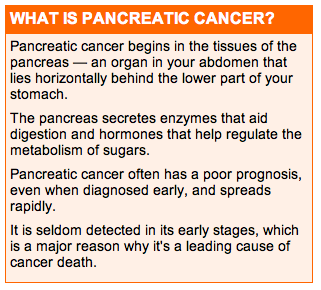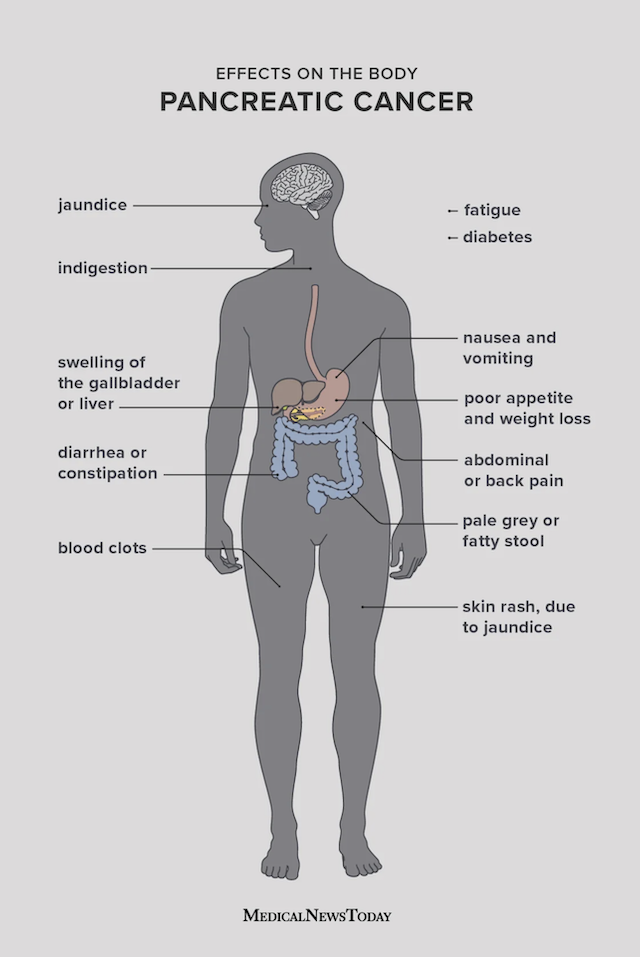When cancer that first formed in the pancreas spreads to other parts of the body, doctors classify it as stage 4 pancreatic cancer.
 The pancreas is an organ that supports the digestive system and helps the body regulate blood sugar. Pancreatic cancer accounts for around 3% of cancers in the United States.
The pancreas is an organ that supports the digestive system and helps the body regulate blood sugar. Pancreatic cancer accounts for around 3% of cancers in the United States.
Pancreatic cancer is difficult to detect early because the pancreas is located deep within the body. People usually have no symptoms until a tumor has become very large or the cancer has spread to other organs.
According to research from 2015, about 53% of people with pancreatic cancer receive a diagnosis when the cancer is in .
Doctors are not able to cure stage 4 pancreatic cancer. Treatment aims to prolong the person’s life, improve their quality of life, and manage their symptoms. Knowing what to expect can help people and their loved ones to cope.
In this article, we describe the symptoms of pancreatic cancer and outline the treatment options when the cancer is in stage 4.
~ What is stage 4 pancreatic cancer? ~

Talking to a therapist may help with the emotional strain of stage 4 pancreatic cancer.
When diagnosing pancreatic cancer, the doctor aims to identify how much cancer is in the body and whether it has spread beyond the pancreas. This process, called staging, helps indicate how serious the cancer is and which treatments are best.
The stages of pancreatic cancer are:
* Stage 0: The cancer is confined to the top layer of the pancreas’ duct cells.
* Stage 1: The cancer is confined to pancreas cells, and the tumor is no bigger than 1.6 inches, about 4 centimeters.
* Stage 2: The tumor may be larger. Or, the cancer may have spread to as many as three lymph nodes but no other organs.
* Stage 3: The cancer may be growing outside the pancreas, into nearby blood vessels. It may also have spread to lymph nodes.
* Stage 4: The cancer has spread to distant sites, such as the liver or lungs.
When cancer spreads to distant organs, this is known as metastasis. The cancerous cells are still pancreatic cells, even though they are growing on other organs.
Pancreatic cancer can metastasize in many areas, including the:
* liver
* stomach
* diaphragm
* adrenal glands
* lungs
* bones
* peritoneum, the tissue that lines the abdomen
Sometimes, doctors can only identify the stage of cancer by performing surgery.
In determining a person’s outlook, healthcare providers consider the cancer’s stage and how abnormal the cancerous cells are. They also take into account the person’s overall health.
When the cancer has spread to other organs, surgeons are not able to remove it or cure it. Treatments for stage 4 cancer involve managing pain and other symptoms to improve the quality of life.
~ Symptoms ~
 Pancreatic cancer can be difficult to detect early because it does not typically cause symptoms in its early stages.
Pancreatic cancer can be difficult to detect early because it does not typically cause symptoms in its early stages.
In a more advanced stage, the cancer may interrupt the functioning of the gall bladder, liver, and bile ducts. This can cause:
* itchy skin
* dark urine
* pale stools
* abdominal pain
* jaundice, which is yellowing of the skin and the whites of the eyes
Other nonspecific symptoms can include:
* unexplained weight loss
* a lack of appetite or feeling full quickly after eating
* indigestion
* depression
* sudden onset of type 2 diabetes that is difficult to control
~ Treatment options ~
While there is no cure for stage 4 pancreatic cancer, treatments can help a person manage their symptoms and improve their quality of life. Options include:
Chemotherapy
Chemotherapy is usually the first-line treatment for stage 4 pancreatic cancer. It involves using targeted medications to kill cancer cells. The goal is to increase the person’s lifespan.
A doctor administers chemotherapy, either as pills or intravenously. It can kill cancer cells in the pancreas and those that have spread to other organs.
For an intense series of columns regarding Chemotherapy, please visit Dr. Kelley’s category, WARNING: Chemotherapy ~ Editor
To treat stage 4 pancreatic cancer, doctors typically use gemcitabine (Gemzar), either alone or in combination with other medications.
Chemoradiation therapy
The medical team may recommend a combination of chemotherapy and radiation therapy, called chemoradiation, for stage 4 pancreatic cancer.
However, chemoradiation generally only treats cancer that has spread to organs near the pancreas, not more distant organs, such as the lungs or liver.
Radiation therapy can also help shrink tumors before or after surgery.
For an intense series of columns regarding Radiation, please visit Dr. Kelley’s category, DANGER: Radiation ~ Editor
Palliative surgery
While surgery cannot cure stage 4 pancreatic cancer, certain procedures can help relieve symptoms. Examples of these surgeries include:
Bile duct stent or bypass
Bile breaks down fats in the digestive system. A buildup of bile due to a blockage can lead to jaundice and a loss of appetite.
When a tumor is blocking a bile duct, a surgeon may use a stent or bypass to help restore the flow of bile.
A bypass involves the surgeon connecting the duct to the small intestine so that the bile can flow around the blockage.
Alternately, the surgeon may insert a small tube, a stent, into the duct to keep it open and prevent a buildup of bile. They may eventually need to replace the stent if the tumor grows and blocks it.
Gastric bypass surgery
A tumor can prevent food from passing through the stomach and into the intestines. Doctors call this a gastric outlet obstruction.
In response, a surgeon can often connect the stomach to the intestine in a different way, forming a bypass.
Medications
Stage 4 cancerous tumors can cause pain and discomfort. A doctor may prescribe pain relief medications, such as opioid analgesics and other drugs that block signals to the nerves.
To help the person cope with the emotional effects of having terminal cancer, the doctor may also recommend:
* anti-anxiety medications
* antidepressants
* sleep aids
Emotional support
Receiving a diagnosis of stage 4 cancer can be distressing and overwhelming. It is normal to experience a range of emotions, such as anger, fear, and grief. Some people also experience anxiety, depression, and difficulty sleeping.
Many people find that joining a support network of others with the same or similar experiences can help them manage day to day.
People can visit the website of The The National Pancreas Foundation for information about joining pancreatic cancer support groups.
In addition, the American Cancer Society offer local programs, services, and community events throughout the U.S.
People can also access support and advice from the National Cancer Institute and the Pancreatic Cancer Action Network.
Other forms of emotional support can also help. They might include:
* talking to supportive friends and family members
* seeing a therapist to work through the emotions and learn coping skills
* learning about pancreatic cancer and a stage 4 diagnosis
* practicing relaxation techniques, if possible, such as meditation, creative therapies, and yoga
* exercising, under a doctor’s guidance
* discussing medical treatment options with one or more doctors
~ Survival Rates ~
Survival rates are estimates of how long a person may live after receiving a certain cancer diagnosis. All survival rates are estimates — a person’s outlook really depends on factors unique to them.
According to the American Cancer Society, when pancreatic cancer has spread to distant organs, the 5-year survival rate is approximately 3%.
However, a person’s age, overall health, and other factors can contribute to their outlook. A doctor will take all of these into consideration and make informed recommendations.
RELATED… What is the survival rate for pancreatic cancer?
Survival rates for pancreatic cancer are improving with developments in treatment. Between 2014 and 2020, the 5-year survival rates for all stages of pancreatic cancer increased from 6% to 10%. Researchers continue to work on improving treatments for this disease.
~ Summary ~
Stage 4 pancreatic cancer has spread beyond the pancreas and into other organs.
Doctors are not able to cure the cancer at this stage, and treatments aim to improve the person’s quality of life, relieve their symptoms, and prolong their life. Many specific factors, including age and general health, play a role in a person’s outlook.
Many people with stage 4 pancreatic cancer and their loved ones benefit from support provided by family, friends, healthcare professionals, cancer organizations, and local or national support groups.
Written by Jayne Leonard and Medically reviewed by Christina Chun, MPH for Medical News Today ~ September 12, 2020
